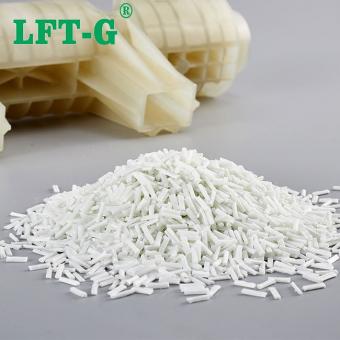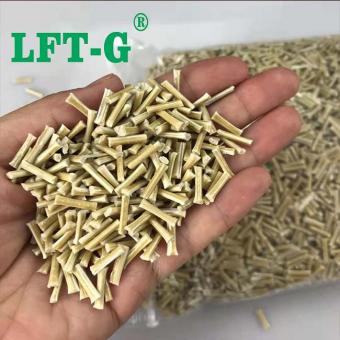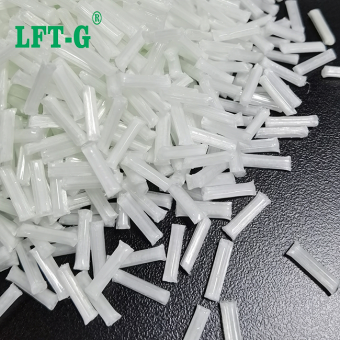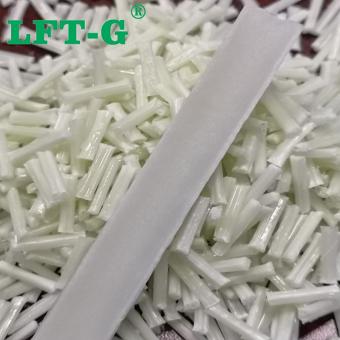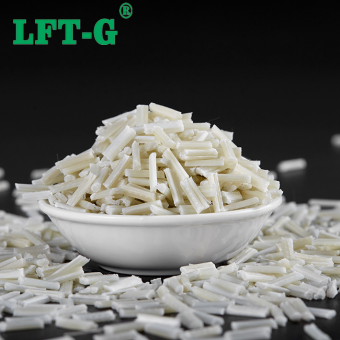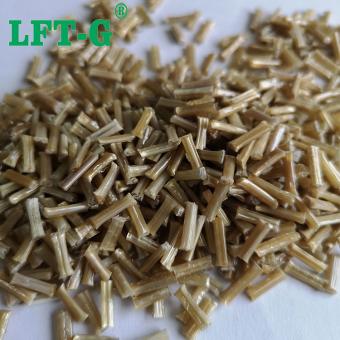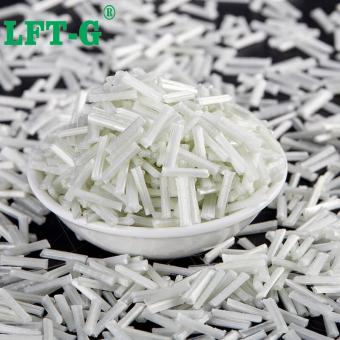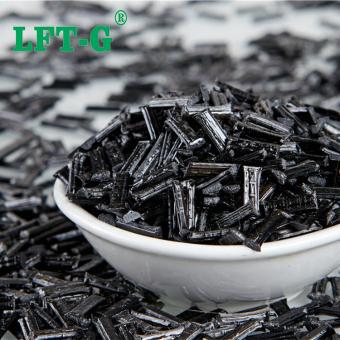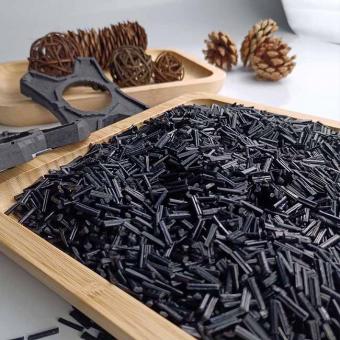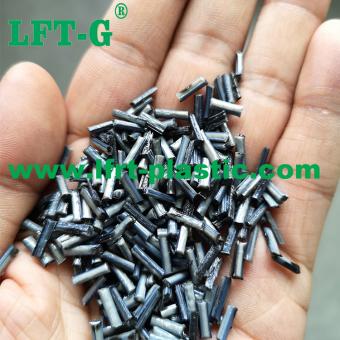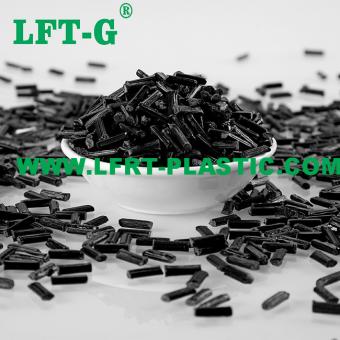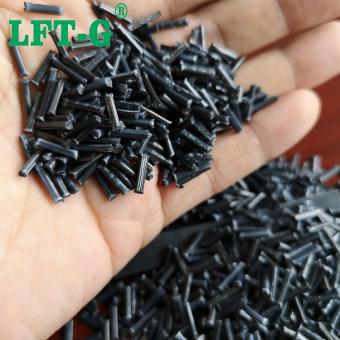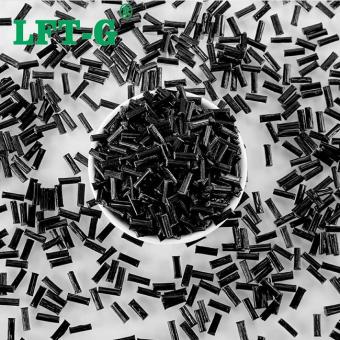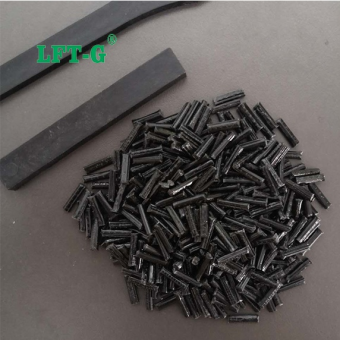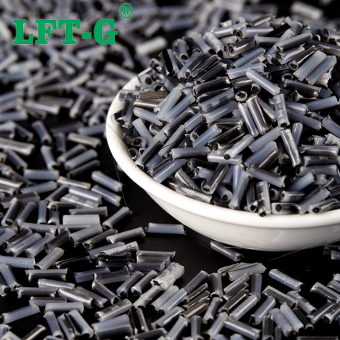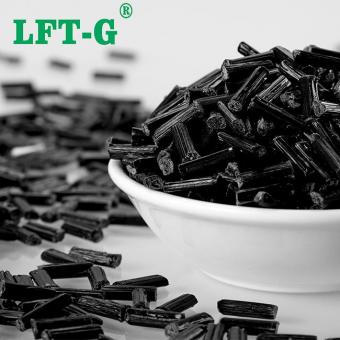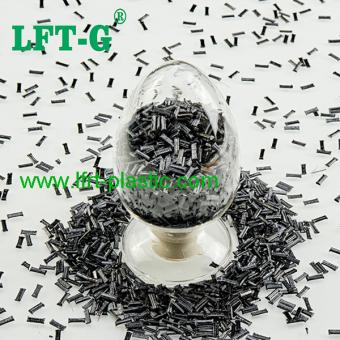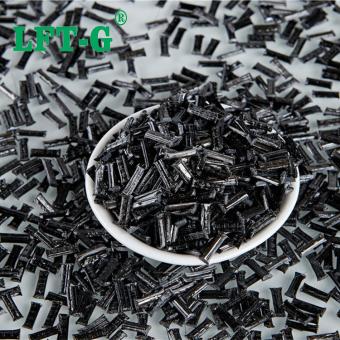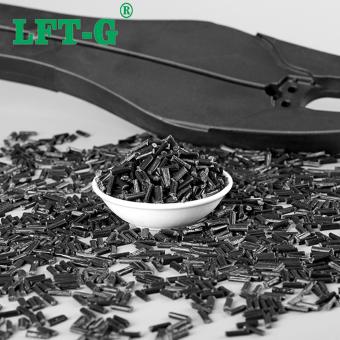Long carbon fiber is a new material with high strength and high modulus and excellent mechanical properties. It is a microcrystalline graphite material obtained by carbonization and graphitization of organic fibers. Its specific gravity is less than 1/4 of steel, and its strength is higher than that of steel. Corrosion resistant, high modulus, no melting. And a variety of resin substrates after impregnation extrusion molding into pellets, long carbon fiber polymer. Can be used for direct molding products. In recent years, it has been widely used in aerospace, mechanical and electronic chemicals.
-
LFT-G modified Polyamide 6 reinforced plastic long carbon fiber filled 40% thermoplastic resin for factoryPolyamide 6 material The chemical and physical properties of PA6 are very similar to those of PA66, and the different molecular structures and properties of PA6 and PA66 also lead to different functions.PA6 has a lower melting point and a wide range of process temperatures, so it is better than PA66 in terms of impact and solubility resistance, but it is also more hygroscopic. Because many of the quality characteristics of plastic parts to be affected by hygroscopicity, molding assembly shrinkage is mainly affected by the material's crystallinity and hygroscopicity, so the use of PA6 design products should be fully considered when this point. Nylon 6 reinforced can reduce the shrinkage of PA6, an effective solution to the moisture-absorbing properties of nylon after the production of parts caused by the problem of high crystallinity, good fluidity performance, making the product more stable. Datasheet Nylon products should be used with attention to the precision error caused by thermal expansion and water absorption, poor acid resistance, poor rotational light resistance; in a long period of high temperature bias environment will be thermally oxidized with the oxygen in the air, the beginning of the color browning, and then rupture. Therefore it is not suitable for outdoor use. However, carbon fiber reinforced modified nylon can be carried out outdoor use, because it improves the poor creep resistance . The use of products with fiber reinforced PA6 not only improves poor creep resistance, but also improves rigidity, wear resistance and strength. *Tips:PA6 filling carbon fiber if not well compatible, will inevitably bring such as floating fiber, poor mechanical properties and other problems, but our products are very good compatibility, there is no such problem. Advantages 01 Strength and durability, excellent combination of rigidity and heat resistance 02 Optimized component design, perfect surface appearance, able to be applied to complex structural molding 03 Good processability, excellent fluidity and thermal stability make the material processing conditions relaxed, so that the injection molded parts miniaturization. 04 Very high thermal stability 05 Constant electrical properties over a wide range of temperatures and frequencies, ensuring 100% safety in the use of installations and equipment. Application Long carbon fiber filled PA6 add carbon fiber to enhance the material, making the products better strength, superior heat resistance, excellent impact resistance, good dimensional stability to meet the requirements of its use in industrial products and daily aspects. In recent years, the car to miniaturization, lightweight development, the engine room volume is reduced, the temperature rises, the requirements of the under-the-hood parts more resistant to high temperatures, and carbon fiber reinforced PA6 can fully meet the above requirements, so the carbon fiber reinforced PA6 automotive products in a wide variety of products, involving automotive engine parts, electrical components, body parts and airbags and other parts. Not only can play a good protective role, but also make the car more beautiful. Carbon fiber reinforced PA6 material has excellent mechanical properties, good dimensional stability, heat resistance, aging resistance has improved significantly. It is often used in automobile engine parts, mechanical parts and aviation equipment parts. Product lengthening carbon fiber reinforced nylon PA6, high fluidity, high rigidity, high mechanical strength, low shrinkage, creep resistance, good thermal stability, high tensile load, wear resistance, good toughness, oil resistance, uniformity of sub-spreading, good material gloss. Can be used for power tools, fishing gear, automobile parts, machinery parts, office accessories and so on. Certifications Quality Management System ISO9001/16949 Certification National Laboratory Accreditation Certificate Moldified Plastics Innovation Enterprise Heavy metal REACH & ROHS testing Factory Contact us
- pa6 lcf granules high rigidity strength
- PA6 long carbon fiber extrusion or injection molding
- thermoplastic resin pa6 with fiber natural black
- Nylon composite pellets Polymer granules PA6
- Long carbon fiber Reinforced Polypropylene for electrial accessories
- LFT-G pellets pa6
Tags :
-
LFT-G Polypropylene compounds long carbon fiber high performance modified plastic automotive parts 12mmThermoplastic prepreg tape composites What are thermoplastic prepreg tape composites? Composites have three elements 1: Matrix resin, e.g. PP, PA 2: Fiber, such as carbon fiber, glass fiber, and 3: fiber morphology, is one-dimensional, or fabric form, different weaving state has different properties; Prepreg is a combination of resin matrix and reinforcement made by impregnating continuous fibers or fabrics with a resin matrix under strictly controlled conditions, and is an intermediate material in the manufacture of composites. Certain properties of prepregs are carried directly into the composite material and are the basis of the composite material. The properties of the composite material depend largely on the properties of the prepreg. PP-LCF composites Long fibre reinforced thermoplastics, LFT for short, uses PP as the most common base resin, by PA, but also PBT, PPS, SAN and other resins, just for different resins need to use different fibers to achieve better results. In the automotive industry, LFT-PP (Long Fiberglass PP) is used in car hoods, instrument panel frames, battery trays, seat frames, car front-end modules, bumpers, luggage racks, spare tire trays, fenders, fan blades, engine chassis, roof racks, etc.. LCF V& SCF In contrast to LFT, SFT (Short fibre reinforced thermoplastics), the biggest difference in their appearance is the difference in the length of the particles and fibers: SFT Particle length: 1-3 mm Length of reinforcing fibers: 0.2 to 0.6 mm LFT Particle length: 6 to 25 mm Reinforcing fiber length: 6 to 25 mm Applications The earliest and most mature application of LFT-PP is in automotive parts. Due to its excellent performance and cost-effectiveness, LFT-PP is increasingly being used in other fields such as instruments, chemical equipment, power tools, gardening tools and so on. e.g. Replacement of staple fiber PA6-GF30 with LFT PP-GF50 No water absorption, higher dimensional stability No change in mechanical properties due to moisture absorption Related materials PA6-LCF PPA-LCF TPU-LCF Frequently asked questions Q. Are there any special process requirements of long carbon fiber for the injection molding products? A. We must consider the requirements of long carbon fiber for the injection molding machine screw nozzle, mold structure and injection molding process. Long carbon fiber is a relatively high cost material, and need to evaluate the cost performance problem in the selection process. Q. What are the advantages of long carbon fiber materials? A. The thermoplastic LFT long carbon fiber material has high rigidity, good impact strength, low warpage, low shrinkage, electrical conductively and electrostatic properties, and its mechanical properties are better than glass fiber series. Long carbon fiber has the characteristics of lighter and more convenient processing to replace metal products. Q. The cost of long fiber products is higher. Does it has a high recycling value? A. The thermoplastic LFT long fiber material can be recycled and reused very well.
- pp long carbon fiber reinoforced plastic modified
- natural balck color PP pellets with filler carbon fiber
- Injection mold and extrusion molding
- Injection molding LCF pp high performance
- PP polypropylene pellets polymers
- reinforced pellets 12mm length best price
Tags :
-
LFT-G PEEK high quality modified materials fill long carbon fiber for automotives good performanceThroughout the plastics industry, PEEK is widely recognized as a leading high performance polymer (HPP). However, the preferred material in the automotive, aerospace, oil and gas, and medical device industries has long been metal, and PEEK polymers are rapidly changing that mindset. What is the PEEK material PEEK or Polyetheretherketone belongs to the class of polymers known as "aromatic polyketones" (more accurately Polyaryletherketone or PAEK). Research and development of PEEK began in the 1960s, but it wasn't until 1978 that Imperial Chemical Industries (ICI) patented PEEK, and Victrex PEEK polymer was first commercialized in 1981. "Aromatic" usually implies a distinctive or sweet flavor, which may seem like an odd term, but scientists use it to describe certain molecules that contain or consist of a cyclic structure (such as the aryl unit above). Small molecules of this type, such as toluene and naphthalene, have distinctive odors and hence the name. However, PEEK itself, like most thermoplastics, is odorless under normal conditions. Chemically, PEEK is primarily a linear semi-crystalline polymer. P comes from the Greek word "poly" meaning "many", so many EEKs form PEEK. aryl and ketone groups provide stiffness by being somewhat rigid, which means good mechanical properties and a high melting point. The ether group provides a degree of flexibility, while the aryl and ketone groups are chemically inert and thus chemically resistant. The regular structure of the repeating units means that the PEEK molecule can be partially crystallized and the crystallinity provides properties such as wear resistance, creep resistance, fatigue resistance and chemical resistance. The resulting polymer is widely recognized as one of the best performing thermoplastics in the world. Compared to metals, PEEK-like materials are lightweight, easy to mold, corrosion-resistant, and have a fairly high specific strength (strength per weight). Datasheet for reference When high performance is required, PEEK as the polymer of choice offers more than just two or three properties, it offers a wide range of excellent properties including: - High heat resistance Testing has shown that LFT-G's PEEK polymer has a continuous use temperature of 260°C (500°F). This allows for a wide range of applications in hot corrosive environments such as the process industry, oil and gas industry, and the engines and transmissions of countless vehicles.PEEK resists friction and wear in dynamic applications such as thrust washers and seals. - Chemically Inert PEEK resists damage caused by chemically corrosive working environments such as downhole environments in the oil and gas industry, and gears in mechanical and automotive applications. It is resistant to jet fuels, hydraulic fluids, de-icers and pesticides used in the aerospace industry for a wide range of pressures, temperatures and time frames. - Strong mechanical properties PEEK exhibits excellent strength and stiffness over a wide range of temperatures, and the specific strength of PEEK-like carbon fiber composites is many times higher than that of metals and alloys. "Creep" is the permanent deformation of a material under constant stress over a period of time. "Fatigue" is the brittle destruction of a material under repeated cyclic loading. Because of its semi-crystalline structure, PEEK has high creep and fatigue resistance and is more durable than many other polymers and metals over a long service life. - Does not ignite or burn easily PEEK has excellent flame resistance, with an ignition temperature of nearly 600°C. Even when ignited at very high temperatures, it does not burn continuously and emits little smoke. This is one of the reasons why PEEK is widely used in commercial aircraft. - Reprocessable and recyclable PEEK molecules are so stable that they can be melted and reprocessed time and time again with minimal impact on their properties. This helps to improve the environmental footprint and ensures more efficient reuse of waste materials generated during the manufacturing process. - And there's more! PEEK is also non-hygroscopic, so its properties are not altered in wet environments; it is resistant to gamma and electron beam radiation and is transparent under X-ray exposure, making it attractive for medical device applications.PEEK is also electrically stable and is typically used as an electrical insulator, but can be modified to become a conductor or static dissipative material. As a thermoplastic PEEK, it can be injection molded, compression molded and extruded using conventional thermoplastic processing equipment. It is very versatile and its use is becoming more and more common to improve component performance, durability, reduce weight and lower overall system costs over its lifetime. There is no doubt that it is replacing metals and alloys. In many industries and critical environments, material specialists, part designers and buyers must choose between PEEK and traditional metals a...
- High performancePEEK fiiler lcf
- Injection molded PEEK good price
- composite plastic peek black color
- made in China peek reinforced materials
- aerospace automotive parts plastic
- Low warpage PPS reinforced long carbon fiber
Tags :
-
LFT-G PPS composites filling long carbon fiber thermoplastic resin natural black color high rigidity for factoryPPS-LCF In carbon fiber composites, carbon fiber reinforced PPS can be said to be a very promising new material, its mechanical properties, corrosion resistance, self-flame retardant and other aspects of the performance is good, so it is often used as a matrix material for various types of high-performance composite materials. The mechanical properties of carbon fiber reinforced polyphenylene sulfide are also affected by the carbon fiber content, under a certain threshold, the larger the carbon fiber content, the stronger the ability to bear external loads. Application Through the reinforcing intervention of carbon fibers, the toughness and strength of polyphenylene sulfide PPS can be substantially increased and improved, becoming one of the most commonly used composites in the aerospace field. Compared with metal, carbon fiber reinforced PPS has the advantages of low cost and easy processing, and the cost can be reduced by 20%-50%. Used in landing gear, wings, doors, fuel tank covers, J-type nose cones, cabin trim and other parts of the aircraft, it not only helps to increase the impact resistance, high temperature resistance and corrosion resistance of these parts, but also improves the load efficiency of the aircraft and reduces fuel consumption by reducing the quality. The most representative application example is the carbon fiber reinforced polyphenylene sulfide composite material for the leading edge of the wing of Airbus A340/A380 aircraft. Datasheet Carbon fiber reinforced PPS production products, with a fast molding, easier to mass production; carbon fiber reinforced PPS with environmental standards, but also able to be used twice, in the production of the entire product as well as the processing of solvents and additives do not need to be introduced, so it can reduce or even a certain degree of avoiding environmental pollution, but also thermoplastic products, unlike thermosetting composite materials can not be reused after the molding of the product, under certain temperature conditions, it has the possibility of recycling, regeneration and reuse. Moreover, unlike thermoset composite products that cannot be reused after molding, thermoplastic products have the possibility of recycling and reuse under certain temperature conditions. In addition, relative to thermoset products, thermoplastic composite products molding speed to be faster, shorter manufacturing cycle, which is conducive to reducing the cost of products. Other materials you may wonder PPA-LCF PEEK-LCF PA12-LCF Tests & Certifications Customers & Us Frequently asked questions 1. Is there a unified reference data for carbon fiber product performance? The performance of specific carbon fiber filaments is fixed, such as Toray's carbon fiber filaments, T300, T300J, T400, T700 and so on, there are a series of parameters can be traced. However, there is no uniform standard to measure the carbon fiber composite products. Firstly, the different types of raw materials selected will lead to different performance of the products, and then due to the choice of matrix and the different design of the products, it will lead to different performance of the products. In addition to some common carbon fiber tubes, carbon fiber boards and other conventional parts, most of the carbon fiber products in the production of the sample before the test to determine whether the performance of the product is in line with the use of the expected standard, and as a base point, so as to carry out the production and use of large quantities. 2. Are carbon fiber composite products expensive? The price of carbon fiber composite products is closely related to the price of raw materials, the level of technology and the quantity of products. Some products of the industrial environment requirements are high, the performance of carbon fiber products and materials have special requirements, which requires the selection of specific raw materials, raw materials, the higher the performance of the natural price of the more expensive, such as the application of orthopedic carbon fiber PEEK thermoplastic materials. Of course, the more complex the production process, the greater t...
- Injection molded PPS reinforced plastic
- PPS made in China LCFR
- raw material pps with filler cf high performance
- Long carbon fiber Reinforced PPS for electrial accessories
- Instead metals materials PPS high performance
- thermoplastic resin PPS with fiber
Tags :
-
lft-g PA66 filled long carbon fiber 20%-60% nylon 66 modified plastic instead metal lightweight smaple availableWhat is the Polyamide 6 material Polyamide resin, the English name for polyamide, referred to as PA. commonly known as nylon (Nylon), it is a macromolecule repeating units in the main chain containing amide groups in the polymer of the general term. For the five engineering plastics in the production of the largest, most varieties, the most widely used varieties. PA66 (polyamide 66 or nylon 66), compared to PA6, is more widely used in the automotive industry, instrument housings and other products that require impact resistance and high strength. What is the Long carbon fiber (LCF) In the modified engineering plastics industry, long fiber reinforced composites are composites produced by a series of special modification methods using long carbon fibers, long glass fibers, aramid fibers, or basalt fibers and a polymer matrix. The biggest feature of long fiber composites is that they have superior performance that the original material does not have, if classified according to the length of the reinforcing material added, they can be divided into: long fiber, short fiber and continuous fiber composites. As mentioned at the beginning, long carbon fiber composites are one kind of long fiber reinforced composites, which is a new type of fiber material with high strength and high modulus fiber.LCF carbon fiber composites show high strength along the fiber axis direction, and have the characteristics of high strength, light weight, etc., and have a full range of mechanical properties such as density, specific strength, specific modulus and so on which are incomparable with other materials, which is a kind of new material with excellent mechanical properties and many special functions. It is a new material with excellent mechanical properties and many special functions. What are the advantages of PA66 filling LCF 1. Good mechanical strength 2. Excellent toughness 3. Excellent wear resistance and self-lubricating properties. 4. Good oil resistance 5. Excellent gas barrier 6. Excellent fluidity and moldability. 7. Excellent heat resistance Applications More application fields you can contact us for more technical advice. Exhibitions 2023 Certifications Quality Management System ISO9001/16949 Certification National Laboratory Accreditation Certificate Modified Plastics Innovation Enterprise Honorary Certificate Heavy metal REACH & ROHS testing Main materials
- pa66 nylon fill lcf home appliance parts
- nylon66 plastic resin modified carbon black
- virgin grade pa66 high performance own factory
- Xiamen LFT-G injection molding pa66
- pa66 composites compounds high quantities good price
- own factory made pa66 lcf pellets
Tags :
-
LFT-G Homo Polypropylene PP filling Long carbon fiber injection molding high toughness and strength compositesPP-LCF composites Polypropylene is a low-cost, excellent performance, widely used polymer materials, through the carbon fiber reinforced, can improve the strength, heat distortion temperature and dimensional stability of polypropylene materials, expanding the application of polypropylene materials, widely used in electronic and electrical appliances, automotive, construction and other fields. Especially in the automotive field, with the development of new energy vehicles and in the trend of automotive lightweight, carbon fiber reinforced materials in the automotive field is more and more widely used. Characteristics of long carbon fiber reinforced polypropylene materials Higher mechanical properties Simple production, easy molding, low warpage Lower density, lightweight, can replace steel with plastic Application The modified polypropylene material reinforced by carbon fiber has a series of advantages such as light weight, high modulus, high specific strength, low coefficient of thermal expansion, high temperature resistance, thermal shock resistance, corrosion resistance, good vibration absorption and so on, and it can be applied to automobile sub-instrument assembly and other automobile parts. Car Tool Kit Automotive front-end components More application fields, please contact us for more technical advice. Frequently asked questions 1. What are the types of thermoplastic carbon fiber composites? Carbon fiber thermoplastic composites are composites with carbon fiber as reinforcing material and thermoplastic resin as matrix. From the reinforcement of carbon fiber, it can be divided into long-cut carbon fiber (LCF)-reinforced thermoplastic composites, short-cut carbon fiber (SCF)-reinforced thermoplastic composites and continuous carbon fiber (CCF)-reinforced thermoplastic composites. Long-cut carbon fiber and short-cut carbon fiber mainly refers to the application length of carbon fiber materials, there is no strict fixed distinction between the two, generally between a few millimeters to a few centimeters, the more common specifications are 6mm, 12mm, 20mm, 30mm, 50mm. Carbon fiber thermoplastic composites can also be classified according to the thermoplastic resin, there are many common thermoplastic resins, such as PE, PP, PVC, etc., but the thermoplastic resin composites reinforced with carbon fibers are mostly used in aerospace, precision equipment, and other demanding working environments, so the carbon fiber thermoplastic composites are more commonly used in the form of polyetheretherketone (PEEK), PPS, polyimide ( Therefore, carbon fiber thermoplastic composites more often use polyether ether ketone (PEEK), PPS, polyimide (PI), polyetherimide (PAI) and other high-end thermoplastic resins as the matrix, to achieve the optimization of the material performance through the way of "strong alliance". 2. How do thermoplastic carbon fiber composites achieve low cost and environmental protection? Thermoplastic carbon fiber composites are used to make parts for high-end machinery, and they have excellent machinability, vacuum forming, stamping mold plasticity and bending processability, etc. Moreover, as long as the material reaches a certain temperature again, it can be remolded, which is recyclable and environmentally friendly in terms of the characteristics of the material itself. For example, Teijin Japan has been able to design a recycling process in the process according to the special needs, and the punched thermoplastic carbon fiber composite material trimmings are shredded, injection molded, and made into recycled materials, which can be used to make small products or injection molded nuts and studs on the carbon fiber prototype parts. This method can reduce the loss of raw materials to a greater extent, improve the use of thermoplastic carbon fiber composite materials, reduce the overall cost, so as to achieve the purpose of environmental protection. Production process of thermoplastic carbon fiber products In addition, thermoplastic carbon fiber composites, compared with thermoset carbon fiber composites, can shorten the molding cycle time due to its special process characteristics, which can further cut down the production cost in terms of production efficiency. 3. Are thermoplastic carbon fiber composites only suitable for injection molding? From the process point of view, injection molding and compression molding compared to a higher degree of automation, the raw material does not contact with the outside world, so the product appearance quality is guaranteed, there will be no black spots, impurities, uneven color and other issues, the mechanical properties of the product, dimensional stability and precision is relatively higher. At present, Toray, Japan, these carbon fiber giants in the application of carbon fiber reinforced thermoplastic composite materials, the main use of injection molding method, and this method is suitable for the production of complex shaped parts and mass production. Com...
- PP pellets lcf 30 polymer
- PP recycled for car parts electric parts
- LFT-G xiamen compounds pp plastic resin
- PP green materials instead metal
- Polypropylene filled lcf 30 40 50
Tags :
-
LFT-G Nylon 12 with filler long carbon fiber LCF 20%-60% compounds high strength lightweight 6-25mmPolyamide 12 PA12, nylon 12, also known as polydodecalactam and polylactam, is a long carbon chain nylon. There are non-polar methylene groups in nylon 12, and the number is large, which makes the flexibility of nylon 12 molecular chain larger; the amide group in nylon 12 is polar, and the cohesion energy is large, and it can form hydrogen bonds between molecules, which makes the arrangement of molecules more regular. Therefore, the crystallinity of nylon 12 is high, and the strength is also higher. Nylon 12 (PA12) has low water absorption, good low temperature resistance, good air tightness, excellent alkali resistance, grease performance, medium resistance to alcohols and inorganic dilute acids and aromatics, good mechanical properties and electrical properties, and is a self-extinguishing material. 1) Density The relative density of nylon 12 is only 1.01-1.03, which is the smallest among all engineering plastics, which has a certain effect on reducing the mass of the car and lowering the fuel consumption. If compared by unit volume, nylon 12 has advantages in price and performance. 2) Melting point The melting point of nylon 12 is 172-178℃, which is slightly lower than that of nylon 11, and it can fully meet the working temperature requirement of automobile fuel and air brake pipes. 3)Water absorption As we all know, the biggest drawback of nylon products is the large water absorption, and it is difficult to ensure the dimensional stability. However, due to the increase of methylene molecules in nylon 12, the influence of hydrophilic groups is greatly reduced, therefore, nylon 12 has the lowest water absorption rate among nylon products, which reduces the change of performance and size of products caused by water absorption, which makes nylon 12 have great advantages. After water absorption, the tensile strength of nylon 12 decreases very little, while nylon 66 and nylon 6 have great changes. 4) Impact strength Impact strength is an important technical index, and it is especially important for nylon 12 tubes that are often exposed to air. Nylon 12 at -20 ℃ and -40 ℃ according to the standard test, no fracture phenomenon, fully meet the requirements of use. Nylon 12 impact resistance is very good. 5)Low temperature performance Nylon 12 has the lowest brittleness temperature of -70 degrees Celsius, so it can be widely used for parts with low temperature resistance. 6) Flexibility The effect of plasticizers on the physical properties of nylon 12 is concentrated on the elastic modulus of the resin. There are three basic types of nylon 12 resins, the main difference between them is the different plasticizer content and the formation of different flexibility. As the content of plasticizer extractable components increases, the elastic modulus of the resin decreases. 7)Low abrasion and low friction properties Nylon 12 has excellent low-wear and low-friction properties and self-lubricating properties, so the frictional noise of Nylon 12 products is very low. 8)Fuel resistance In the automobile, the current use of oxygenated fuel, high aromatic fuel and alcohol mixed fuel will lead to the decomposition of many hose materials. Only nylon 11, nylon 12 and fluorocarbon elastomers have been tested for use in this environment. Under the action of motor fuels, all nylons dissolve, resulting in dimensional changes, especially in methanol-containing gasoline, where nylons containing large amounts of amide groups such as nylon 6 dissolve much more than nylons containing small amounts of amide groups such as nylon 12 %. It is found that the fuel containing 15% methanol has a great effect on nylon. 9) Resistant to zinc chloride solution Zinc chloride will appear in the environment under the car. Under certain temperature and humidity, the salt on the road reacts with galvanized steel or zinc-containing primer to form a small amount of zinc chloride. Zinc chloride is highly corrosive, but Nylon 12 is highly resistant to zinc chloride solutions. Ozone aging, UV exposure, temperature conditions, etc., can bring varying degrees of damage to parts and reduce service life. Since nylon 12 does not contain the + 2 3 2 + unsaturated double bond, which is susceptible to ozone attack, it does not suffer from ozone aging. In addition, the high crystallinity of nylon 12 and its high melting temperature make it more stable in terms of heat resistance, and the addition of heat stabilizers increases its heat resistance exponentially. When exposed to sunlight, its energy can cause the chemical bonds of organic materials to break. The bonding energy of C-H, C-O and C-N bonds in nylon 12 is so large that UV light is not enough to break them, but only the C-C bonds with smaller bonding energy; therefore, after adding appropriate anti-aging agents to the raw materials, the UV resistance of nylon 12 is excellent. Polyamide 12 - Long carbon fiber In the modified engineering plastics industry, long fiber reinforced composites are composites made fr...
- polyamide 12 engineering plastics lcf
- reinforced nylon 12 cfrp black
- injection molding pa12 carbon fiber
- thermoplastic resin pa12 with fiber
- LFT-G new materials pa12 cf instead metal
- green plastic recycled pa12 lcf
Tags :
-
LFT-G Polyamide 6 compounds long fiber carbon 20%-60% low warpage high strength for auto partsPolyamide 6 plastic Nylon 6 (PA6), also known as polyamide 6, nylon 6, its mechanical strength and crystallinity is good, and has corrosion resistance, wear resistance and other characteristics, in the automotive industry, rail transportation, film packaging, electronic appliances and textiles and other major fields to achieve a wide range of applications. Although its comprehensive performance, but also has a series of shortcomings, such as PA6 does not have too strong resistance to strong acid and alkali, low temperature, dry state impact strength is not high, the presence of hydrophilic groups will cause high water absorption, modulus of elasticity, creep resistance, impact strength and other water absorption will be significantly reduced, thus affecting the dimensional stability of the product, but also affect the electrical properties of the product. Therefore, it is necessary to do a good research on the modification of PA6. Polyamide 6 filling long carbon fiber Carbon fiber reinforced composites are composite materials composed of high strength fibers and elastic plastics, which have high stiffness and strength, making the products superior heat resistance, excellent impact resistance, and good dimensional stability, meeting their requirements for use in industrial and everyday aspects. PA6-LCF has higher stiffness and strength than traditional polyamide, and the addition of carbon fiber increases the thermal stability of the material and improves its wear resistance, making it a composite material with high strength, high impact resistance and resistance to thermal deformation. TDS for reference Application fields Lab & Factory We can provide you LFT & LFRT material technical parameters and leading edge design Mold front design and recommendations Provide technical support such as injection molding and extrusion molding
- Nylon 6 lcf lft-g
- self owing pa6 pellets
- Nylon composite pellets Polymer granules
- pa6 resin filler cfrp
- long glass fiber filler pa6
- pa6-lcf good price
Tags :
-
LFT-G Homo PP long carbon fiber filler polypropylene high mechanical properties sample available natural blackLong carbon fiber (LCF) Carbon fiber was first used in aviation, military and other fields, and later was cited in the production of racing car parts. In recent years, it began to come into the consumer market, and is also one of the materials that international manufacturers are keen on. Carbon fiber composite materials are characterized by very light, rigid, and can withstand the same pressure as steel, the cost is higher. However, the material is more durable and has a high recycling value, so it can save costs to a certain extent. Carbon fiber composites include carbon fiber powders, short fibers, long fibers, and long fiber reinforced composites. Long carbon fiber composites have better mechanical properties than short carbon fiber composites, but there are certain requirements for the injection molding machine and mold of the product. Carbon fiber has excellent mechanical properties and chemical stability, lower density than aluminum, higher strength than steel, is the highest specific strength and highest specific modulus among the high-performance fibers that have been produced in large quantities, and has the characteristics of low density, corrosion resistance, high temperature resistance, friction resistance, fatigue resistance, high electrical and thermal conductivity, low coefficient of thermal and wet expansion, etc. It is an important strategic material for the development of national defense and national economy. The characteristics of corrosion resistance, high temperature resistance and low coefficient of expansion make it an alternative material to metal materials in harsh environments; the electrical and thermal conductivity properties expand its application in the field of communications and electronics; as the highest specific strength (strength to density) and highest specific stiffness (modulus to density) among the high-performance fibers currently in mass production, carbon fiber is an important material for aerospace, wind power blades, new energy vehicles, transportation, sports and leisure, etc, Carbon fiber is an ideal material for aerospace, wind power blades, new energy vehicles, transportation, sports and leisure, and other fields with light weight needs. Xiamen LGT-G LCF compounds have the following appearance: Flat grain, very light weight, shows flawless finish, no floating fibers, bubbles, etc. The color is natural black and the length is around 6 to 25 mm. Application Datasheet for reference Homo-PP & Copo-PP PP is divided into homopolymer PP and copolymer PP according to the different types of monomers involved in polymerization. Homopolymer PP is made by polymerization of propylene monomer only, and there is only one kind of link in the polymer molecular chain, with high crystallinity and good mechanical properties and heat resistance. Copolymerized PP is mainly made of propylene monomer and ethylene monomer, and there are ethylene links in addition to propylene links in the polymer molecular chain, which has high impact resistance. HPP composites and CPP composites, both of them are available for us. Details Number Color Length Package Sample MOQ Port of Loading Delivery time HPP-NA-LCF Natural color, or customized 6-25mm 20kg/bag Available 20kg Xiamen Port 7-15 days after shipment Test Xiamen LFT composite plastic CO., Ltd. Xiamen LFT composite plastic Co., Ltd. is a brand-name company that focuses on LFT&LFRT. Long Glass Fiber Series (LGF) & Long Carbon Fiber Series (LCF). The company's thermoplastic LFT can be used for LFT-G injection molding and extrusion, and can also be used for LFT-D molding. It can be produced according to customer requirements: 5~25mm length. The company's long-fiber continuous infiltration reinforced thermoplastics have passed ISO9001&16949 system certification, and the products have obtained lots of national trademarks and patents.
- best long carbon fiber pp lcf30 granules
- carbone fiber reinforced pp pellets
- pp lcf injection mold extrusion
- pp modified granules manufacturer
Tags :
-
LFT-G PEEK engineering plastic fill long carbon fiber 30% composites high rigidity strength for automotive partsPEEK plastic PEEK is a comprehensive performance of excellent special engineering plastics, with excellent heat resistance, chemical resistance, radiation resistance, electrical properties, flame retardant properties, etc.. Its molecular chain is a polymer composed of a benzene ring and connected ketone and ether groups, and the benzene ring ensures that PEEK materials have good rigidity, and the ether bond ensures that PEEK has good toughness, so that PEEK is a comprehensive material with both toughness and rigidity. PEEK has the following outstanding properties: (1) Extremely high heat resistance. Can be used at 250 ° C for a long time, instantaneous use of the temperature up to 300 ° C, at 400 ° C for a short period of time almost no decomposition. (2) excellent mechanical properties and dimensional stability. PEEK can maintain high strength at high temperatures, bending strength at 200°C is still up to 24 MPa, 250°C bending strength and compression strength of up to 12-13 MPa, especially suitable for manufacturing at high temperatures can work continuously in the components. In addition, PEEK also has good creep resistance, can be used in the period of great stress, not due to the extension of time to produce significant extension. (3) Excellent chemical resistance. Even at high temperatures PEEK resists corrosion of most chemicals very well, with corrosion resistance similar to that of nickel steel. The only thing that can dissolve PEEK under normal conditions is concentrated sulfuric acid. (4) Good resistance to hydrolysis. Can resist chemical damage from water or high-pressure water vapor. Under high temperature and pressure conditions, PEEK components can work continuously in aqueous environments while still maintaining good mechanical properties. If immersed in water at 100 ° C for 200 days, the strength remains almost unchanged. (5) Good flame retardant properties. It can reach UL 94 V-0 level, has self-extinguishing property, and releases less smoke and toxic gas under flame condition. (6) Good electrical properties. In a wide range of frequencies and temperatures, PEEK can maintain the same electrical properties. (7) High radiation resistance. PEEK has a very stable chemical structure, in high doses of ionizing radiation PEEK parts can also work properly. (8) Good toughness. Fatigue resistance to alternating stress is the most outstanding of all plastics, comparable to alloy materials. (9) Excellent resistance to friction and wear. It can maintain high wear resistance and low friction coefficient at 250°C. (10) Good processing performance. Easy to injection molding and high molding efficiency. PEEK-LCF compounds Long carbon fiber modified PEEK materials at room temperature, the tensile strength doubled compared to unreinforced, reaching three times at 150°C. At the same time, the reinforced composites also received a substantial increase in impact strength, flexural strength and modulus, with a dramatic reduction in elongation and heat deflection temperatures that can exceed 300°C. The impact energy absorption rate of the composites directly affects the performance of the composites when subjected to impact, and carbon fiber-reinforced peek composites show a specific energy absorption capacity of up to 180 kJ/kg. Application Long carbon fiber modified peek materials are widely used in the fields of aerospace, automotive manufacturing, electrical and electronics, medical and food processing. For example, applied to orthopedic medical devices, thanks to carbon fiber-reinforced PEEK used in orthopedics five major performance advantages: light weight and strength, wear resistance, good biocompatibility, corrosion resistance, good X-ray permeability, it can be done intramedullary nailing PEEK aiming rod bracket, distal locking with PEEK aiming frame, external fixation bracket with X-ray permeable PEEK heel linkage (spark surface), minimally invasive PEEK guided tail (aiming rod), etc. TDS for reference Different properties with different fiber specification The content of long fiber is not more is better. The suitable content is just to meet the requirements of each products. Produce process Our materials are suitable for injection molding and extrusion molding. Parts of Certifications Quality Management System ISO9001/16949 Certification National Laboratory Accreditation Certificate Modified Plastics Innovation Enterprise Honorary Certificate Heavy metal REACH & ROHS testing Q & A Q. Does long glass fiber and long carbon fiber injection have special requirements for injection molding machines and molds? A. There are certainly requirements. Especially from the product design structure, as well as the injection molding machine screw nozzle and mold structure injection molding process must consider the requirements of long fiber. Q. What are the differences and advantages of long fiber materials and thermosets and staple fibers? A. Compared with the short fiber, is has more excellent performanc...
- PEEK LCF 30 composites
- peek injection mold resin materials
- good price peek self factory
- peek conpounds reinforced plastic
- peek low warpage lfrt
- peek CFRP pellets polymers
Tags :
-
LFT-G PPS Polyphenylene sulfide composite long carbon fiber injection mold thermoplastic resin high toughnessPPS material In recent years, the application of special engineering plastics has gradually extended from the previous military and aerospace fields to more and more civil fields, such as automotive, equipment manufacturing, high-end consumer goods, etc.. Among them, polyphenylene sulfide (PPS) and polyether ether ketone (PEEK) are two special engineering plastics that have developed relatively quickly and have a wide range of applications. PEEK is superior to PPS in terms of strength, toughness, and maximum operating temperature. In terms of high-temperature resistance, PEEK is about 50°C higher than PPS. But on the other hand, the relatively obvious cost advantages and better processing properties of PPS make it more widely used. PPS is a crystalline, highly rigid white powder polymer, high heat resistance (long-term use of 200 ℃ -220 ℃, short-term can withstand high temperatures of 260 ℃), is a mechanical strength, rigidity, flame retardant, chemical resistance, electrical properties, dimensional stability are excellent resin. It has excellent wear resistance, creep resistance, flame retardancy and self-extinguishing properties. It maintains good electrical properties at high temperature and high humidity. Good flowability, easy to mold, almost no shrinkage and concave spot when molding. Good affinity with various inorganic fillers. It has been developed to shorten the difference between standard thermoplastic materials (e.g. PA, POM, PET ......) and advanced engineering plastics. PPS has the following distinct performance advantages: (1) Intrinsically Flame Retardant Unlike PC and PA, PPS pure resin and its glass fiber/mineral powder filled composites without any added flame retardants 可以轻松达到V-0@0.8mm甚至更薄厚度的V-0阻燃级别. Although PC and PA have a cheaper price and better mechanical strength (especially impact strength) than PPS, the cost of PC and PA composites with the addition of halogen-free flame retardant formulations (V-0@0.8mm级别) is significantly higher, in many cases even higher than PPS materials with the same mechanical strength. (2) Ultra-high flowability For the semi-crystalline PPS, its very high fluidity can allow glass fiber filling easily more than 50 %, while in the process of high-temperature melt blending extrusion, PPS compared to PC lower viscosity can make the glass fiber to withstand a lower degree of shear and extrusion, so that the final injection molded products have a longer retention length, to further enhance the effect of modulus. (3) Ultra-low water absorption This advantage is mainly for PA. In terms of fluidity, highly filled PA and PPS are comparable; and for mechanical properties, the same amount of filling PA composites will be more advantageous. But in addition to the halogen-free flame retardant limitations, another factor limiting the application of PA is its high water absorption: compared to high-temperature nylon PA6T 0.6%-1% water absorption, PPS 0.03% water absorption rate is almost negligible. The result is that PPS products due to water absorption and deformation of the product defect rate is much lower than the same conditions of PA products. (4) the unique metallic texture and higher surface hardness PPS injection molded parts will be dropped on the table, a very crisp sound unique to PPS crash. Through the special mold and reasonable mold temperature with the PPS injection molded parts in the human touch will also sound similar to the impact of metal, the surface will be as smooth as a mirror, with a metal-like luster. PPS-LCF compounds Length: About 12mm, or customized Color: Original color, or customized Fiber specification: 20%-60% Grade: General grade Long carbon fiber reinforced composites offer significant weight savings and provide optimum strength and stiffness properties in reinforced thermoplastics. The excellent mechanical properties of long carbon fiber reinforced composites make it an ideal replacement for metals. Combined with the design and manufacturing advantages of injection molded thermoplastics, long carbon fiber composites simplify the re-imagining of compoents and equipment with demanding performance requirements. Its widespread use in aerospace and other advanced industrials makes it a "high-tech" perception of consumers. Datasheet for reference Application Factory Q & A 1. Is there a uniform reference data for carbon fiber product performance? The performance of specific carbon fiber filaments is fixed, such as Toray's carbon fiber filaments, T300, T300J, T400, T700, etc. There are a series of parameters that can be traced. However, there is no uniform standard to measure the carbon fiber composite products. Firstly, the different models of raw materials selected will lead to different performance of the products, and then the different selection of substrate and product design will lead to different performance of the products. In addition to some common carbon fiber tube, carbon fiber plate and other conventional parts, most of th...
- PPS long carbon fiber injection
- PPS reinforced plastic LCF
- LFT-G PPS resin cf
- raw material pps with filler cf
- automotive parts plastic pps toughness
- black color pps fill long fiber
Tags :
-
LFT-G PA66 with filler long carbon fiber 40% specification reinforced plastic high toughness sample availablePolyamide 66 Nylon is the common name for polyamide (PA), a generic term for thermoplastic resins containing repeating amide groups on the main chain of the molecule, including aliphatic polyamides, aliphatic-aromatic polyamides and aromatic polyamides. As one of the top five engineering plastics, nylon has an extremely wide range of industrial applications, mainly in automotive parts, mechanical parts, electronics and appliances, cosmetics, adhesives and packaging materials. Among them, the largest production and most widely used are aliphatic polyamides, mainly nylon 66 and nylon 6. Nylon 66 (PA66) is made by condensation of adipic acid and hexanediamine, which is a class of polyamide. Advantages: high strength, corrosion resistance, good wear resistance characteristics, and has self-lubricating, flame retardant, non-toxic environmental protection and other excellent performance. Disadvantages: poor heat resistance and acid resistance, low impact strength in dry state and low temperature, high water absorption affects the dimensional stability and electrical properties of products. Polyamide 66 filling long carbon fiber High-performance fibers are chemical fibers with high load-bearing capacity and high durability because they have a special physical or chemical structure embodied with some excellent characteristics that traditional fibers do not have, such as high temperature resistance, corrosion resistance, flame retardancy and other properties. Carbon fiber is an inorganic polymer material with carbon content higher than 90% obtained from organic fibers through carbonization and graphitization. Advantages: light weight, high strength, high modulus, high temperature resistance, wear resistance, corrosion resistance, fatigue resistance, electrical conductivity, thermal conductivity, etc. Disadvantages: high cost, relatively difficult to infiltrate, poor transparency, etc. Carbon fiber composite materials are very useful structural materials, which are not only light, high temperature resistant, but also have high tensile strength and elastic modulus, and are indispensable materials for the manufacture of spacecraft, rockets, missiles, high-speed aircraft and large passenger aircraft. In transportation, chemical industry, metallurgy, construction and other industrial sectors, as well as sports equipment and other aspects have a wide range of applications. The density of PA66/CF composites tends to increase slightly as the content of CF increases. This is due to the fact that the density of CF is larger compared to that of PA66. The fracture surface of PA66 is smoother, while the fracture surface of PA66/CF sample is extremely rough and CF is pulled out, which indicates that the CF in the system plays a good role in bearing the load when the composite sample is subjected to external force, and this fracture is a ductile fracture, therefore, PA66/CF composite is a ductile material. With the increase of CF content, the tensile strength of PA66/CF composites increased significantly. The flexural strength and flexural modulus of PA66/CF composites are increased substantially with the increase of CF content. Datasheet for reference We can provide PA66 filiing Long carbon fiber 20%-60%. If you need more datas, please contact us. Application Our products are mainly suitable for large products such as structural parts and load-bearing parts, and the above applications are for reference only. If you have other products, please feel free to consult our technical experts to provide you with 1-to-1 service. Laboratory & Warehouse Teams & Customers Welcome to contact us for more informations!
- Polyamide66 reinforced plastic cf
- long carbon fiber filling nylon66
- thermoplastic resin pa66 cfrp
- injection mold pa66-lcf compounds
- composite long carbon fiber PA66 black
- high performance pa66 carbon fiber modified
Tags :

 e-mail
e-mail English
English français
français Deutsch
Deutsch русский
русский italiano
italiano español
español português
português العربية
العربية 日本語
日本語 한국의
한국의 中文
中文




